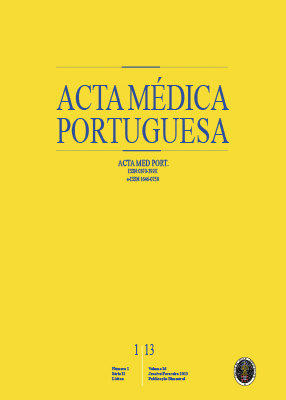Ovarian Hyperstimulation Syndrome: Experience of a Reproductive Medicine Center 2005-2011
DOI:
https://doi.org/10.20344/amp.4008Abstract
Introduction: Ovarian Hyperstimulation Syndrome is a complication of controlled ovarian hyperstimulation during cycles of Assisted Medical Reproduction. The objective of this work was to analyze those cycles to achieve a better knowledge of this pathology, namely risk factors and strategies for prevention and treatment of Ovarian Hyperstimulation Syndrome . Materials and Methods: Retrospective analysis of 4870 ART cycles (2005 - 2011), with moderate (27) and severe (24) Ovarian Hyperstimulation Syndrome . Data was analyzed for patients’ characteristics, stimulation protocol, embryologic and clinical outcomes, and treatment performed. Results: In Ovarian Hyperstimulation Syndrome groups the mean ages and the doses of rFSH + HMG were lower, and the serum E2 levels, doses of HCG, number of oocytes retrieved as well as the rates of blastocyst, biochemical and clinical pregnancy, implantation, newborns, very preterm birth and newborns with low and very low weight were significantly higher. Patients with severe Ovarian Hyperstimulation Syndrome were hospitalized and received only support measures with no complications. Discussion: Ovarian Hyperstimulation Syndrome is associated with conditions that can bring risk to the fetus, namely prematurity and low birth weight, so the pregnancy should be carefully monitored in these cases. Conclusions: Young age is a risk factor for Ovarian Hyperstimulation Syndrome and high serum E2 levels may predict a higher risk too and thus should induce the adoption of prevention strategies.
Downloads
Downloads
Published
How to Cite
Issue
Section
License
All the articles published in the AMP are open access and comply with the requirements of funding agencies or academic institutions. The AMP is governed by the terms of the Creative Commons ‘Attribution – Non-Commercial Use - (CC-BY-NC)’ license, regarding the use by third parties.
It is the author’s responsibility to obtain approval for the reproduction of figures, tables, etc. from other publications.
Upon acceptance of an article for publication, the authors will be asked to complete the ICMJE “Copyright Liability and Copyright Sharing Statement “(http://www.actamedicaportuguesa.com/info/AMP-NormasPublicacao.pdf) and the “Declaration of Potential Conflicts of Interest” (http:// www.icmje.org/conflicts-of-interest). An e-mail will be sent to the corresponding author to acknowledge receipt of the manuscript.
After publication, the authors are authorised to make their articles available in repositories of their institutions of origin, as long as they always mention where they were published and according to the Creative Commons license.









